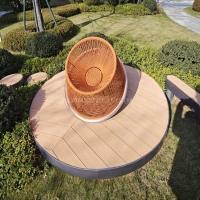Welcome to the website for landscape facilities products and knowledge.
What are the most effective ways to create a seamless transition between a landscape bar counter and outdoor seating walls?
A truly exceptional outdoor living space dissolves the boundary between interior comfort and exterior beauty. The connection between a landscape bar counter and adjacent outdoor seating walls presents a prime opportunity to craft this seamless experience. While many settle for a simple pass-through window, the most effective integrations transform the entire area into a cohesive entertaining zone. The goal is not just adjacency, but a fluid conversation between materials, sightlines, and function.
The foundation of this seamless transition is a deliberate and thoughtful material palette. Selecting a primary material that performs well both indoors and out is paramount. For instance, a honed or leathered granite countertop can extend from the interior bar, over the seating wall, and become a durable outdoor surface. Similarly, using the same cladding—such as stacked stone, textured tile, or charred wood shou sugi ban—on both the bar's interior base and the exterior face of the seating walls creates a powerful visual link that tricks the eye into perceiving one continuous structure.
The treatment of the threshold itself is the next critical element. Rather than a solid wall with a simple window, consider large, operational glazing. Floor-to-ceiling sliding glass doors, multi-panel bi-fold doors, or even a pivot door completely remove the physical barrier when open, effectively merging the two spaces. This maximizes airflow, light, and social interaction, making the bartender a part of the outdoor party. For a more architectural approach, a cantilevered countertop that extends uninterrupted from inside to outside through a weather-sealed slot in the glass creates a stunning and functional effect.
Beyond the grand gestures, meticulous detailing ensures the transition feels polished. Continuity in flooring is powerful; running large-format porcelain tiles from the interior right out to the patio, or using complementary materials like internal hardwood and external composite decking laid in the same direction, extends the sense of space. Integrated lighting is also crucial. LED strip lighting under the interior and exterior lip of the countertop, or recessed pathway lights in the seating walls, will draw the eye along the connection point and create a magical ambiance after dark.
Finally, unify the spaces through purpose and planting. An overhead pergola or extended roof eave that shelters both the interior bar area and the outdoor seating zone defines them as a single room. Strategically placed container gardens or raised planters filled with herbs on the seating walls not only add greenery but also become a functional extension of the bar, providing fresh garnishes within arm's reach. By mastering these elements—material continuity, innovative threshold design, detailed lighting, and functional landscaping—you can successfully erase the line between inside and out, creating a dynamic and inviting environment for all your guests.
Related search:

Recommendation
Swivel chair-Specialty steel structure woven rattan leisure chair with rotatable design